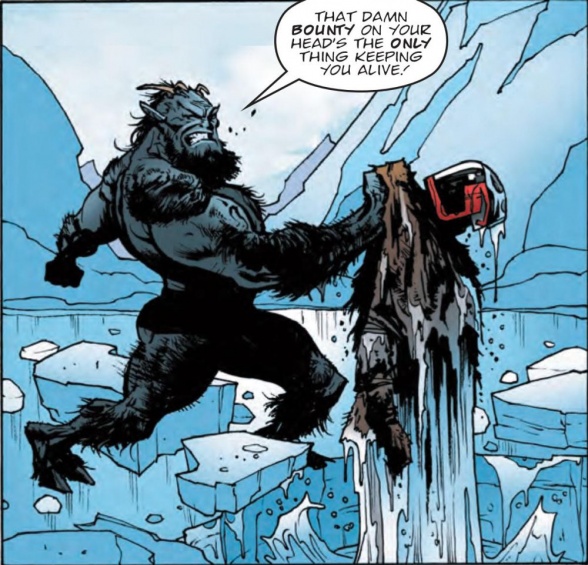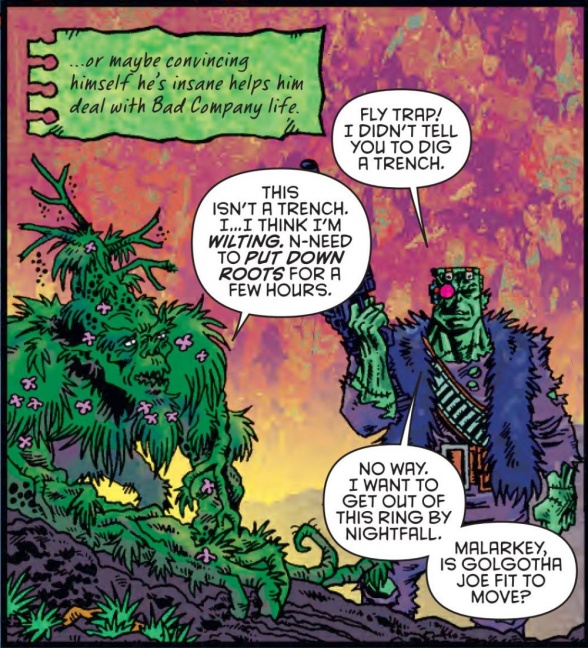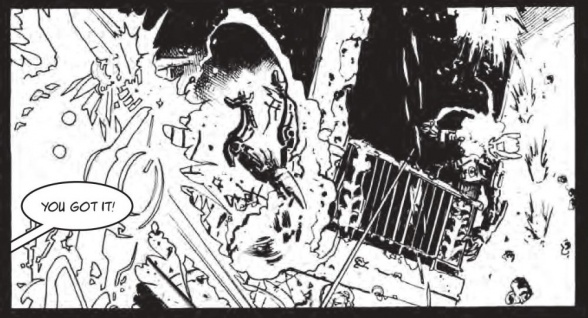
Welcome, Earthlets, to Multiver-City One, our “2000 AD” weekly review column! Every Wednesday we examine the latest offerings from Tharg and the droids over at Rebellion/2000 AD, the galaxy’s leading producers of Thrill-Power entertainment. Let’s get right to it!

THIS WEEK IN 2000AD

“Judge Dredd: The Shroud Part 4”
Credits: Michael Carroll(script), Paul Davidson(art), Chris Blythe(Colors), Annie Parkhouse(letters)
Greg Lincoln: This week ‘The Shroud’ comes to an end and, though it was an okay action tale, there was really terribly little that stands out about this story arc.
This week, Dredd executed his daring escape plan with the apt aid of his accomplice Shirokov. The plan was pretty clever in his use of the squidipede attraction to heat and Maul’s tendency to blind rage. Overall, the plan relied a bit too heavily on Maul and his men not being all that bright and the timely arrival of Soviet Judge Zima. It all plays out rather a bit too nicely, stretching the suspension of disbelief.
Paul Davidson delivers five pages of good action that reveal the story of Dredd’s plan as much as the dialogue does. No exposition of the details was necessary as we are shown how it all plays out step by step. He included a Dredd’s eye view of Maul at one point, to bring home Dredd’s hope to make Maul a hot target for the creatures he’d been making the slaves capture. There is nothing bad or off in the art colors of letters of this weeks story; it’s all there working well together, but little stands out in a story. Even though there are some hints of Davidson’s command of expression peppered through the strip, it’s all at mid-distance, so they lacked the impact of the precious weeks closeups.
An alright arc that, baring future appearances of the sporty Nuala, the criminal ally Shirokov or the enigmatic Maul, is be little more than a speed bump in Dredd’s return to Mega City One.

Bad Company: Terrorists, Part 8
Credits: Peter Milligan (script), Rufus Dayglo (art), Dominic Regan (colors), Simon Bowland (letters)
Tom Shapira: There’s an old Talmudic idiom “Tafasta merube lo tafasta” which translates into “seize too much and you have sized nothing.” The latest chapter in “Terrorists,” which sees Bad Company zeroing-in on colonel Crowley’s location as team member Golgotha Joe goes haywire, is more than ‘nothing’ but it definitely is a bit too much. Golgotha Joe going into overload is such a great visual moment (and kudus to Dayglo’s pencils for selling the chaos of the scene without losing control) but this is where the short page count of 2000AD story just doesn’t leave the story enough room to breathe.
This chapter is just too rushed for its own good – trying to move on from the horrific injuries of the last battle, sowing some inner-team conflict and throwing some Ararat flashbacks for good measure. “Bad Company” remains a fun read, but sometimes you got to take your foot off the gas to provide some emotional resonance for the action scenes.

Savage: The Thousand Year Stare Book 2 Part 8
Credits: Pat Mills(script) Patrick Goodard(art) Ellie De Ville (letters)
Michael Mazzacane: Goodard’s use of black in ‘Savage’ has shifted over the strips run, this time he uses it to make really nice silhouettes. The solid black outlines stand out and make the fire fire and gunfire really pop and read as energetic, as everything goes down around Hitler’s old hospital. All that beautiful graffiti he drew up in smoke. In contrast Goodard use of space and perspective make for a similar effect as Savage, Voldana, Quartz, and that other baddie, have their dance of death. And then, when things finally take the turn to a Mexican Standoff all that space is eliminated. Goodard gets to work in some gnarly detail on the burned guys face. There’s something kinda funny about the amount of absurd weaponry everyone has pointed at one another each trying to out maneuver or get a clear shot on the other.
For 6 pages there is a lot of variety of styles in this strip, and that style isn’t for its own sake it is the core of why this strip works dramatically. After a good while of character drama and exposition things finally kick back up a notch and it hits those same tones from the start of this series where everyone was on the run from something leading into the next strip.
Continued belowTo continue the this is all a dream thread from last week, isn’t the sudden appearance of the Pirates rather dreamlike? At the same time with how these strips operate with the passage of time from strip to strip, it’s totally in keeping with the series as a whole.

Brass Sun: Engine Summer, Part 8
Credits: Ian Edginton (script), INJ Culbard (art), Ellie de Ville (letters)
Kent Falkenberg: Sometimes, there’s nothing better than just sitting back and lapping up the cool fluidity of INJ Culbard’s smooth-lined technique. And this week is a fantastic opportunity to do so, as Ian Edginton delivers a near-silent script in ‘Engine Summer, Part 8.’
Opening with a wordless sequence on an unnamed world, we as readers could be thrown into a land of confusion. But the clarity of Culbard’s art depicts the scene with such steady pacing that it feels like we’re just watching someone’s regimen of spearing a fish, swimming to shore, cleaning the meat, and cooking a meal by spit over an open flame. It doesn’t really matter we’re not totally clear on who it is we’re watching, the simple fact we’re watching someone run through their usual paces is enough to provide an anchor.
Of course, Edginton’s thrown us a curveball by means of an unspecified time jump after last week’s explosive finish. And while there are many questions raised – Where’s Septimus? How long has Wren been on this new world? What state of disarray has the greater Orrery been left in? – the fact he devoted the bulk of ‘Engine Summer, Part 8’ to the Wren running through her daily routine gives the jump a lived-in, earned quality.
‘Engine Summer, Part 8’ is a transitional chapter. And it’s a welcome breather after the intensity Edginton and Culbard just hit. There’s a new status quo and some new mysteries to solve. For now, though, the strip is content to mainly watch someone going through the motions. But when it’s INJ Culbard drawing those motions, they’re a pretty sight to behold.

ABC Warriors: Fallout, Part Eight
Credits: Pat Mills(script), Clint Langley (art), Annie Parkhouse (letters)
Rowan Grover: As much as the first few chapters of “Fallout” were oddly scattered and unevenly paced, I admit that they have made the reveals in this chapter so much more satisfying than they have any right to be. Mills keeps the story back trundling along after some middling parts, having the Warriors figure out who is truly behind each of their suffering: The Volgan Robots, led by Blackblood. Howard Quartz hilariously and satisfyingly reveals to Blackblood in a very Golden Age Detective manner how each one of the warriors will figure out it all links back to him, with a sliding pace that crescendos to a perfect cliffhanger. Mills has set the whole story back on track for it’s sprint to the end, and it looks like it will come colliding in a manic and super-fun way.
We get something in this chapter that isn’t super common in Langley’s art, and that’s a section that’s not overly busy and more atmospheric. Granted, it’s only about a page and a half, but I feel like it was a well-executed eye of the storm moment that looks beautiful. The transition takes place after fading away from Gottlieb and Ro-Jaws’ conversation into space, giving a very ethereal and literal otherworldly tone. We get to see some deep, glittering reds of Z’s nuclear missiles launching into space, and a great, almost lonely shot of the ship the Black Butterfly drifting through space. There’s a lot of other great aspects of this chapter too, and a lot of that happens in the Warriors’ comebacks in the last third. Langley paints each Warrior as finally showing a spark of their old selves, and this works best in the shots of Z and Tubal Caine, who both look unique to their personalities.
This chapter of ‘Fallout’ shows the story marching towards its conclusion in certified style. Mills has the chapter work as a great total realisation of villainy, and Langley gets the chance to render a spectacular quieter moment. All in all, this story took me pleasantly by surprise.






